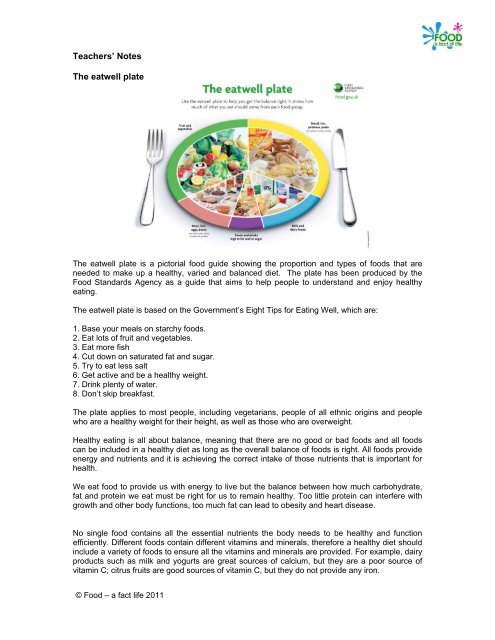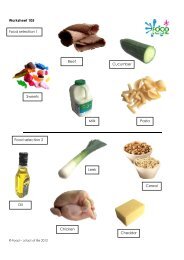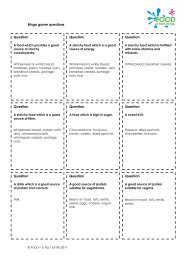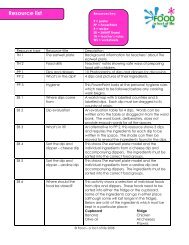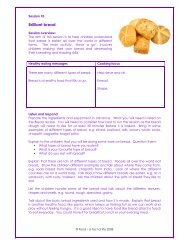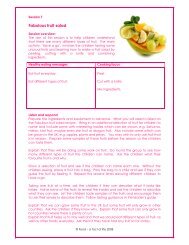Eatwell plate - Guide 100.pdf - Food a fact of life
Eatwell plate - Guide 100.pdf - Food a fact of life
Eatwell plate - Guide 100.pdf - Food a fact of life
Create successful ePaper yourself
Turn your PDF publications into a flip-book with our unique Google optimized e-Paper software.
Teachers’ Notes<br />
The eatwell <strong>plate</strong><br />
The eatwell <strong>plate</strong> is a pictorial food guide showing the proportion and types <strong>of</strong> foods that are<br />
needed to make up a healthy, varied and balanced diet. The <strong>plate</strong> has been produced by the<br />
<strong>Food</strong> Standards Agency as a guide that aims to help people to understand and enjoy healthy<br />
eating.<br />
The eatwell <strong>plate</strong> is based on the Government’s Eight Tips for Eating Well, which are:<br />
1. Base your meals on starchy foods.<br />
2. Eat lots <strong>of</strong> fruit and vegetables.<br />
3. Eat more fish<br />
4. Cut down on saturated fat and sugar.<br />
5. Try to eat less salt<br />
6. Get active and be a healthy weight.<br />
7. Drink plenty <strong>of</strong> water.<br />
8. Don’t skip breakfast.<br />
The <strong>plate</strong> applies to most people, including vegetarians, people <strong>of</strong> all ethnic origins and people<br />
who are a healthy weight for their height, as well as those who are overweight.<br />
Healthy eating is all about balance, meaning that there are no good or bad foods and all foods<br />
can be included in a healthy diet as long as the overall balance <strong>of</strong> foods is right. All foods provide<br />
energy and nutrients and it is achieving the correct intake <strong>of</strong> those nutrients that is important for<br />
health.<br />
We eat food to provide us with energy to live but the balance between how much carbohydrate,<br />
fat and protein we eat must be right for us to remain healthy. Too little protein can interfere with<br />
growth and other body functions, too much fat can lead to obesity and heart disease.<br />
No single food contains all the essential nutrients the body needs to be healthy and function<br />
efficiently. Different foods contain different vitamins and minerals, therefore a healthy diet should<br />
include a variety <strong>of</strong> foods to ensure all the vitamins and minerals are provided. For example, dairy<br />
products such as milk and yogurts are great sources <strong>of</strong> calcium, but they are a poor source <strong>of</strong><br />
vitamin C; citrus fruits are good sources <strong>of</strong> vitamin C, but they do not provide any iron.<br />
© <strong>Food</strong> – a <strong>fact</strong> <strong>life</strong> 2011
The <strong>plate</strong> is divided into five food groups:<br />
<strong>Food</strong>s from the largest groups should be eaten most <strong>of</strong>ten and foods from the smallest group<br />
should be eaten least <strong>of</strong>ten. The guide is shaped like a dinner <strong>plate</strong> which has been designed to<br />
make healthy eating simpler to understand and interpret.<br />
The eatwell <strong>plate</strong> shows the types <strong>of</strong> foods that fit into the five commonly accepted food groups<br />
and the proportions <strong>of</strong> these foods that should be eaten from each group. People should be<br />
encouraged to choose a variety <strong>of</strong> foods from the four largest groups every day to ensure that<br />
they obtain the wide range <strong>of</strong> nutrients their bodies need to grow, develop and/or function<br />
properly and stay healthy.<br />
More foods should be eaten from the bread, rice, potatoes, pasta and other starchy foods group<br />
and the fruit and vegetables group compared with the milk and dairy foods group and the meat,<br />
fish, eggs, beans and other non-dairy sources <strong>of</strong> protein group. <strong>Food</strong>s in the smallest group –<br />
foods and drinks high in fat and/or sugar – add choice and palatability but foods from this group<br />
should be used sparingly if they are eaten every day (such as butter and spreads) or not eaten<br />
too <strong>of</strong>ten (such as sweets and crisps).<br />
It is not necessary to achieve this balance at each meal but it should be applied to food eaten<br />
over a day or even a week. The amounts that should be consumed will vary depending on energy<br />
needs (based on age, sex and physical activity levels) and appetite. Dishes containing more than<br />
one food can also fit into the model. For example, a pizza has a dough base with toppings. The<br />
dough base counts as a starchy food so having a thick base is a good idea. If the pizza is homemade<br />
the topping could be made with a reduced fat cheese or less cheese and more tomato.<br />
Including a side salad with the pizza would increase the amount <strong>of</strong> vegetables eaten, and fruit<br />
could be eaten to complete the meal.<br />
© <strong>Food</strong> – a <strong>fact</strong> <strong>life</strong> 2011
Key message<br />
The key message from the eatwell <strong>plate</strong> is that having a balance and variety <strong>of</strong> foods in the diet is<br />
important for health. Aiming to achieve this balance every day is a sensible and practical<br />
approach, although it is not necessary to achieve it at every meal. Choosing different foods from<br />
within each group is also important as this adds to the range <strong>of</strong> nutrients consumed, as well as<br />
variety to the diet.<br />
© <strong>Food</strong> – a <strong>fact</strong> <strong>life</strong> 2011
Fruit and vegetables<br />
Eating at least five portions <strong>of</strong> fruit and vegetables every day is<br />
recommended for health. All fruits and vegetables count except for<br />
potatoes. Fruits and vegetables do not need to be fresh or raw;<br />
canned, dried, frozen, juices or cooked in soups and stews are just as<br />
good and all count towards 5 A DAY.<br />
Fruits and vegetables are low in fat and high in dietary fibre, so help to<br />
provide us with a range <strong>of</strong> important nutrients without exceeding our<br />
energy requirements. We need dietary fibre in our diet to help us<br />
maintain a healthy gut. Fruit and vegetables are good sources <strong>of</strong><br />
soluble dietary fibre which is important for heart helath.<br />
They also contain vitamins and minerals – the main ones being<br />
vitamin C, vitamin A and folate. Some fruit and vegetables are higher<br />
in some vitamins and minerals that others e.g. bananas are high in<br />
potassium, where as dried apricots are high in iron. This is why it is<br />
important to eat a range <strong>of</strong> fruit and vegetables rather than having the<br />
same ones all the time – a good saying to remember is ‘eat a rainbow!’<br />
Fruit and vegetables also contain substances known as antioxidants<br />
which help protect against diseases such as cancer and heart disease.<br />
Top tips:<br />
• Choose fruit or chopped vegetables as a snack.<br />
• Add dried or fresh fruit to breakfast cereals.<br />
• Have a salad with sandwiches or with pizza.<br />
• Add vegetables to casseroles and stews and fruit to desserts.<br />
• Try not to eat the same fruit and vegetables every day.<br />
Bread, rice, potatoes, pasta and other starchy foods<br />
<strong>Food</strong>s from this group should make up a third <strong>of</strong> the food we eat and<br />
be included at each meal. They provide us with energy in the form <strong>of</strong><br />
starchy carbohydrates. Eating more starchy foods such as bread,<br />
potatoes, rice and pasta helps to reduce the amount <strong>of</strong> fat and<br />
increase the amount <strong>of</strong> insoluble dietary fibre in the diet. Wholemeal<br />
and wholegrain versions should be included as well as white or refined<br />
versions to improve dietary fibre intake, which keeps the gut healthy.<br />
Potatoes, yams, plantains and sweet potato fall into this group, rather<br />
than fruit and vegetables, because they contain starchy<br />
carbohydrates.<br />
• Base your meals around foods from this group.<br />
• Eat wholegrain or wholemeal breads, pastas and cereals as well as<br />
white choices.<br />
• Choose low fat oven chips rather than fried chips (oven chips fall into<br />
this food group but fried chips don’t).<br />
• Avoid frying or adding too much fat to these foods.<br />
© <strong>Food</strong> – a <strong>fact</strong> <strong>life</strong> 2011
Milk and dairy foods<br />
These foods provide calcium and are very important in the diet for<br />
good bone health. These foods should be eaten in moderate amounts<br />
every day.<br />
Try to choose lower fat versions whenever you can, such as semiskimmed<br />
milk, low fat yogurt and reduced fat cheese.<br />
• Choose lower fat milk, i.e. semi-skimmed, 1% or skimmed milk.<br />
• Choose low fat yogurts and reduced fat cheeses.<br />
Meat, fish, eggs, beans and other non-dairy sources <strong>of</strong> protein<br />
These foods provide protein for growth and development and minerals<br />
such as iron, zinc and magnesium and also B vitamins. Leaner cuts <strong>of</strong><br />
meat and lower fat versions <strong>of</strong> these foods should be included. Visible<br />
fat and skin should be trimmed from meat and poultry, and cooking<br />
methods should be used that do not add fat, e.g. grilling, baking,<br />
steaming or poaching instead <strong>of</strong> frying. This helps to reduce the<br />
amount <strong>of</strong> saturated fat in the diet.<br />
It is recommended that fish should be included in the diet at least twice<br />
a week and that at least one <strong>of</strong> these is an oily fish, e.g. salmon, trout,<br />
mackerel or sardines.<br />
Other sources <strong>of</strong> non dairy protein include nuts, t<strong>of</strong>u, mycoprotein,<br />
textured vegetable protein (TVP), beans such as kidney beans and<br />
canned baked beans, and pulses such as lentils.<br />
• Choose lower fat meat products.<br />
• Choose lean cuts <strong>of</strong> meat.<br />
• Remove visible fat including skin from meat and poultry and drain<br />
away fat after cooking.<br />
• Try to grill, poach, steam, bake or microwave meat and fish rather<br />
than frying.<br />
• Eat oily fish once a week.<br />
© <strong>Food</strong> – a <strong>fact</strong> <strong>life</strong> 2011
<strong>Food</strong>s and drinks high in fat and/or sugar<br />
These foods should be eaten in small amounts. Some <strong>of</strong> these<br />
foods, such as oils and spreads, are typically eaten every day, so<br />
they should be used sparingly and lower fat alternatives should be<br />
used where possible. Other foods, such as cakes and biscuits,<br />
should be not be eaten too frequently. <strong>Food</strong> and drinks containing<br />
sugar should be eaten as part <strong>of</strong> meals, rather than between meals.<br />
• Eat small quantities <strong>of</strong> these foods.<br />
• Choose low fat or reduced sugar foods where possible.<br />
• Use spreads and oils sparingly – opt for vegetable fats and oils.<br />
• Try to limit consumption <strong>of</strong> sugar-containing foods and drinks<br />
between meals.<br />
• Try not to add fat to foods when cooking.<br />
Fluids<br />
It is important to drink enough to remain well hydrated. One <strong>of</strong> the most common causes <strong>of</strong> inability to concentrate<br />
is dehydration. Even mild dehydration <strong>of</strong> around 2% affects concentration, yet not enough to stimulate feelings <strong>of</strong><br />
thirst. Drinking plenty <strong>of</strong> water can help concentration, sports performance and prevent headaches.<br />
The body needs about 1.2 litres (6 – 8 glasses) <strong>of</strong> fluid per day (all drinks count except for alcohol). When the<br />
weather is hot, or during and after exercise or strenuous activity, more fluid is needed to replace what is lost from<br />
the body.<br />
Further information<br />
Department <strong>of</strong> Health www.dh.gov.uk<br />
British Nutrition Foundation www.nutrition.org.uk<br />
British Dietetic Association Teen WeightWise www.teenweightwise.com<br />
© <strong>Food</strong> – a <strong>fact</strong> <strong>life</strong> 2011


